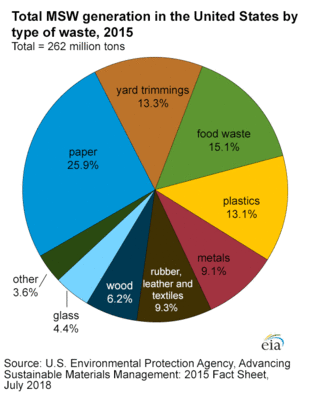Energy from Waste
Wood Waste
Wood waste is the left-over scrap after wood has been prepared for commercial uses. It consists of bark, sawdust, wood chips, wood scrap, and paper mill residues. Most of the wood waste is used in residences, industries, electric power producers and various commercial businesses. Wood waste accounts for approximately 2% of total U.S. annual energy consumption. In 2017 wood and wood waste was used proportionately as follows by sector:
- Industry - 69%
- Residential - 16%
- Electric Power Generation - 12%
- Commercial - 4%
Municipal Solid Waste

Source: EIA Energy Explained
Municipal solid waste (MSW) can contain components that can be used as sources of energy. MSW consists of plant or animal products, paper, food, wood, grass, leaves and a myriad of other biomass types of products.
MSW also consists of plastics, glass, metals and other non-biomass components.
MSW is used by waste-to-energy plants that burn the waste products and use the resulting heat to generate electricity. This is not only beneficial in that it reduces the use of fossil fuels; it also greatly reduces the volume of municipal waste.
Biogas
Biogas consists of 40% - 60% methane with carbon dioxide as an additional component. There are also some trace amounts of other gases in the mixture. Proportions of all the gas comprising biogas depends on the source of the gas.
Most biogas is derived from the decomposition of municipal landfill, sewage, or agricultural waste products. Municipal landfill containing most biomass substances will decay, producing biogas as one of their products. Agricultural wastes such as animal manure and bedding material from barns can be processed in digester tanks to produce biogas products.